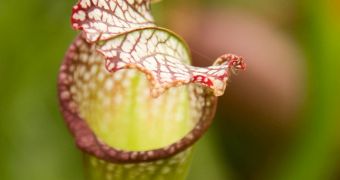Scientists from the Harvard University School of Engineering and Applied Sciences (SEAS) announce the creation of a new type of material, which exhibits little to no friction under a wide variety of conditions. The stuff can repel nearly any type of fluids or liquids.
Members of the research team say that they drew inspiration from carnivorous pitcher plants in their study. These plants have leaves that become nearly-frictionless surface shortly after a rain, allowing the plant to catch insects and even tiny amphibians.
Over millions of years, these types of vegetation have developed advanced methods of capturing prey, which involve setting a bait through smell and colors, and then a trap in the form of a slippery surface that takes victims to their doom.
In order to make the trap very effective, the plants had to make their surface very slippery. A similar approach can be seen on lotus flowers, which float on water, but have extremely hydrophobic leaves.
SEAS investigators decided to create their own type of bio-inspired liquid repellency technology, and managed to produce a material that can repel anything from water and blood to oil, and which retains these capabilities even when subjected to very low temperatures and very high pressures.
Details of their approach were published in the September 22 issue of the top scientific journal Nature. The team also listed potential applications for the new material, and the list is extensive. Most commonly, it may be used to create self-cleaning windows.
Additional uses could be found in optical devices, fuel transport, technologies related to removing fouling and preventing frost, as well as the handling of dangerous chemicals such as acids.
“Inspired by the pitcher plant, we developed a new coating that outperforms its natural and synthetic counterparts and provides a simple and versatile solution for liquid and solid repellency,” researcher Joanna Aizenberg explains.
She holds an appointment as the SEAS Amy Smith Berylson Professor of Materials Science, and is also the director of the Kavli Institute for Bionano Science and Technology. The expert is a Core Faculty member at the Wyss Institute for Biologically Inspired Engineering at Harvard as well.
The new material the team developed is called Slippery Liquid-Infused Porous Surfaces (SLIPS), and is a porous material that is covered with lubricating fluid. The pores are actually structures carved in the material at the nano- and microscales.
“Not only is our bio-inspired surface able to work in a variety of conditions, but it is also simple and cheap to manufacture. It is easily scalable because you can choose just about any porous material and a variety of liquids,” SEAS PhD student and study co-author Sung Hoon Kang explains.

 14 DAY TRIAL //
14 DAY TRIAL //